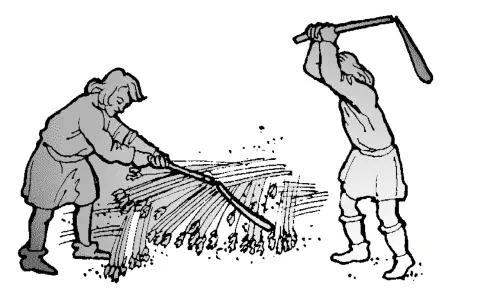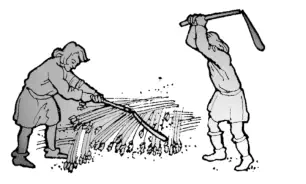


Langham Village History Group ~ © 1996 - 2025
Agriculture


From the earliest days, when woodland would have been cleared to create fields, agriculture was important to the people of Langham. After the Norman Conquest, the villagers would have been
tenants of the Lord of the Manor of Oakham or of Westminster Abbey and worked on the lord’s land as well as cultivating their own strips of land. The open field system of farming, with tenants
renting strips of land, began in its simplest form in Saxon times, became more developed after the Norman Conquest and continued until the mid 18
th
century. Then began major changes in
agriculture, with the enclosure of open fields; increasing demand for food for an increasing population; the introduction of new fodder crops and improved breeds of livestock. By the mid 19
th
century
farm mechanisation was occurring.
Common Land
As well as the cultivated land, an area would be kept as meadow for the growing of hay. The remaining land in the parish would be common land, available to the villagers to graze their animals.
In Langham, The Pastures, to the south of Cold Overton Road, were still in use until the mid 20
th
century. Some of the old record books of the Pastures Committee survive, showing the rates for
mowing thistles and the payment for fetching the cows. The Pastures was also a favourite haunt of village children who played there and hoped to be rewarded for opening the gates.
Allotments
The introduction of allotments by Richard Westbrook Baker helped to alleviate the problems caused by the Enclosures Acts. Rented allotment plots gave the poorer villagers the opportunity to grow
vegetables and corn for the pig. They were also important during both World Wars. Langham’s first allotments were in Ashwell Road and due to the lie of the land, were known as Allotment Hill and
Allotment Hollow. The present allotment field came into use in the 1860s.
Gardens
Cottage gardens would also have produced vegetables for the table. A newspaper report from September 1915 records Langham’s first Vegetable Show. It was held on Miss Finch‘s lawn and this lady
hoped that the Show would become an annual event. It did; though it ceased in the 1940s. The Village Show’s revival took place in 1977 and now (2009) includes flowers, vegetables, cookery and
junior exhibits.




Langham Village History Group ~ © 1996 - 2025
Agriculture


From the earliest days, when woodland would have been cleared to create fields, agriculture was important to the
people of Langham. After the Norman Conquest, the villagers would have been tenants of the Lord of the Manor of
Oakham or of Westminster Abbey and worked on the lord’s land as well as cultivating their own strips of land. The open
field system of farming, with tenants renting strips of land, began in its simplest form in Saxon times, became more
developed after the Norman Conquest and continued until the mid 18
th
century. Then began major changes in
agriculture, with the enclosure of open fields; increasing demand for food for an increasing population; the introduction
of new fodder crops and improved breeds of livestock. By the mid 19
th
century farm mechanisation was occurring.
Common Land
As well as the cultivated land, an area would be kept as meadow for the growing of hay. The remaining land in the parish
would be common land, available to the villagers to graze their animals.
In Langham, The Pastures, to the south of Cold Overton Road, were still in use until the mid 20
th
century. Some of the old
record books of the Pastures Committee survive, showing the rates for mowing thistles and the payment for fetching the
cows. The Pastures was also a favourite haunt of village children who played there and hoped to be rewarded for
opening the gates.
Allotments
The introduction of allotments by Richard Westbrook Baker helped to alleviate the problems caused by the Enclosures
Acts. Rented allotment plots gave the poorer villagers the opportunity to grow vegetables and corn for the pig. They were
also important during both World Wars. Langham’s first allotments were in Ashwell Road and due to the lie of the land,
were known as Allotment Hill and Allotment Hollow. The present allotment field came into use in the 1860s.
Gardens
Cottage gardens would also have produced vegetables for the table. A newspaper report from September 1915 records
Langham’s first Vegetable Show. It was held on Miss Finch‘s lawn and this lady hoped that the Show would become an
annual event. It did; though it ceased in the 1940s. The Village Show’s revival took place in 1977 and now (2009) includes
flowers, vegetables, cookery and junior exhibits.


















